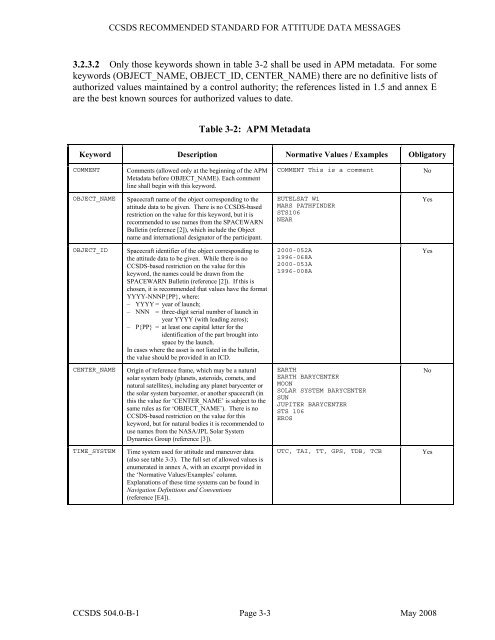Attitude Data Messages - CCSDS
Attitude Data Messages - CCSDS
Attitude Data Messages - CCSDS
Create successful ePaper yourself
Turn your PDF publications into a flip-book with our unique Google optimized e-Paper software.
<strong>CCSDS</strong> RECOMMENDED STANDARD FOR ATTITUDE DATA MESSAGES<br />
3.2.3.2 Only those keywords shown in table 3-2 shall be used in APM metadata. For some<br />
keywords (OBJECT_NAME, OBJECT_ID, CENTER_NAME) there are no definitive lists of<br />
authorized values maintained by a control authority; the references listed in 1.5 and annex E<br />
are the best known sources for authorized values to date.<br />
Table 3-2: APM Metadata<br />
Keyword Description Normative Values / Examples Obligatory<br />
COMMENT<br />
Comments (allowed only at the beginning of the APM<br />
Metadata before OBJECT_NAME). Each comment<br />
line shall begin with this keyword.<br />
COMMENT This is a comment<br />
No<br />
OBJECT_NAME<br />
Spacecraft name of the object corresponding to the<br />
attitude data to be given. There is no <strong>CCSDS</strong>-based<br />
restriction on the value for this keyword, but it is<br />
recommended to use names from the SPACEWARN<br />
Bulletin (reference [2]), which include the Object<br />
name and international designator of the participant.<br />
EUTELSAT W1<br />
MARS PATHFINDER<br />
STS106<br />
NEAR<br />
Yes<br />
OBJECT_ID<br />
Spacecraft identifier of the object corresponding to<br />
the attitude data to be given. While there is no<br />
<strong>CCSDS</strong>-based restriction on the value for this<br />
keyword, the names could be drawn from the<br />
SPACEWARN Bulletin (reference [2]). If this is<br />
chosen, it is recommended that values have the format<br />
YYYY-NNNP{PP}, where:<br />
– YYYY = year of launch;<br />
– NNN = three-digit serial number of launch in<br />
year YYYY (with leading zeros);<br />
– P{PP} = at least one capital letter for the<br />
identification of the part brought into<br />
space by the launch.<br />
In cases where the asset is not listed in the bulletin,<br />
the value should be provided in an ICD.<br />
2000-052A<br />
1996-068A<br />
2000-053A<br />
1996-008A<br />
Yes<br />
CENTER_NAME<br />
Origin of reference frame, which may be a natural<br />
solar system body (planets, asteroids, comets, and<br />
natural satellites), including any planet barycenter or<br />
the solar system barycenter, or another spacecraft (in<br />
this the value for ‘CENTER_NAME’ is subject to the<br />
same rules as for ‘OBJECT_NAME’). There is no<br />
<strong>CCSDS</strong>-based restriction on the value for this<br />
keyword, but for natural bodies it is recommended to<br />
use names from the NASA/JPL Solar System<br />
Dynamics Group (reference [3]).<br />
EARTH<br />
EARTH BARYCENTER<br />
MOON<br />
SOLAR SYSTEM BARYCENTER<br />
SUN<br />
JUPITER BARYCENTER<br />
STS 106<br />
EROS<br />
No<br />
TIME_SYSTEM<br />
Time system used for attitude and maneuver data<br />
(also see table 3-3). The full set of allowed values is<br />
enumerated in annex A, with an excerpt provided in<br />
the ‘Normative Values/Examples’ column.<br />
Explanations of these time systems can be found in<br />
Navigation Definitions and Conventions<br />
(reference [E4]).<br />
UTC, TAI, TT, GPS, TDB, TCB<br />
Yes<br />
<strong>CCSDS</strong> 504.0-B-1 Page 3-3 May 2008

















